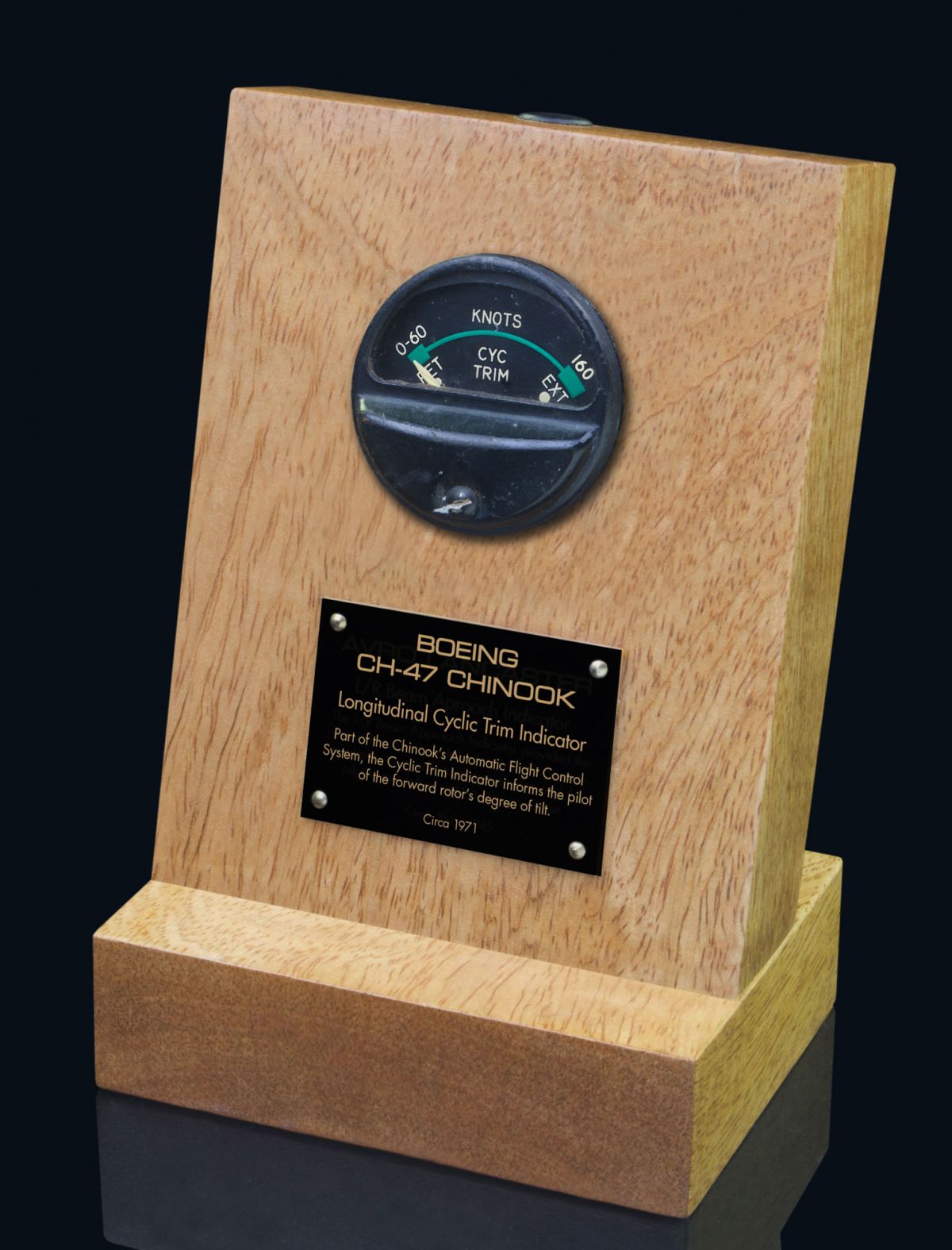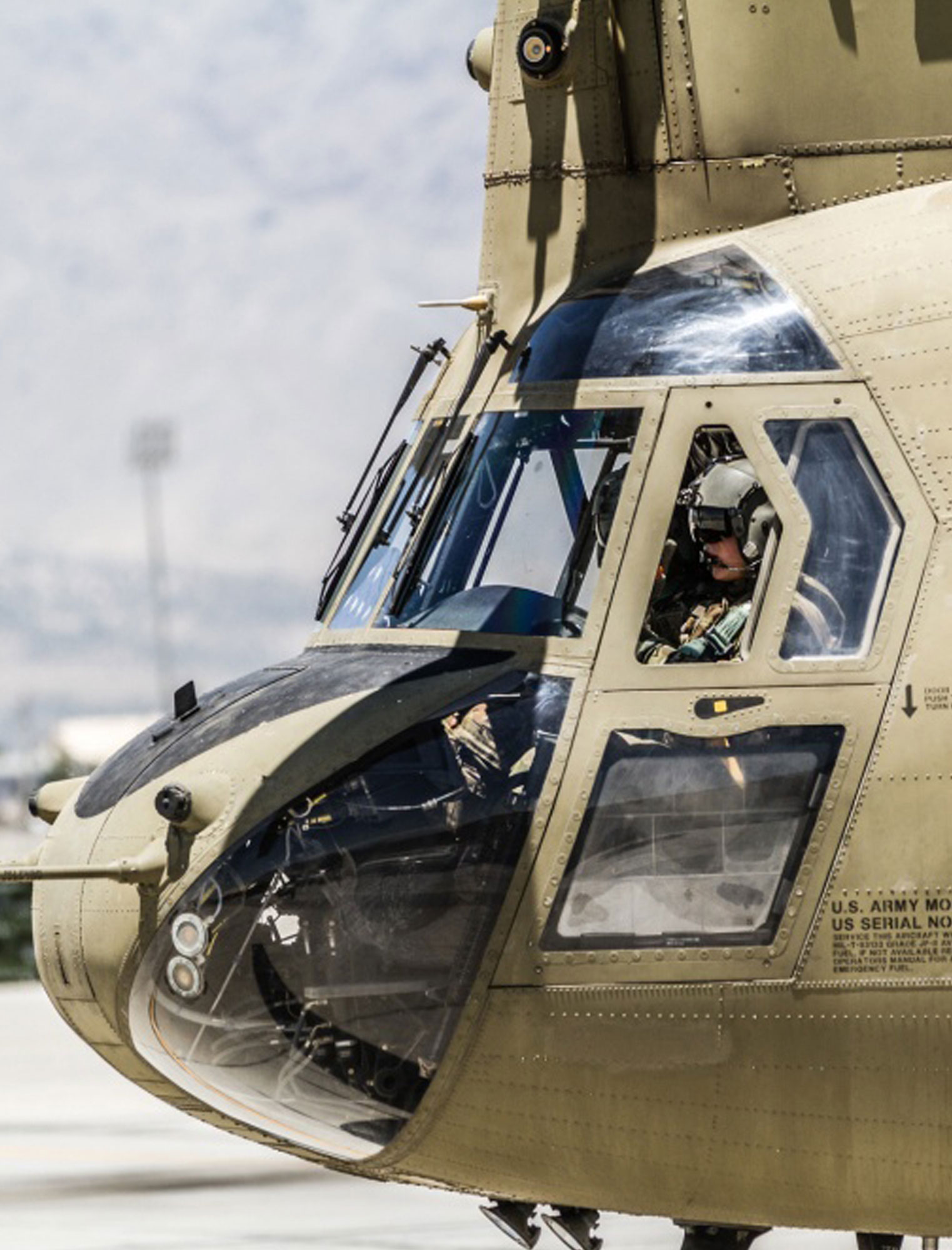- AUST POST SHIPPING
- 0438 654 235
- info@recoverycurios.com
- P.O. Box 7640 Cairns QLD Australia, 4870
-
0
Shopping Cart

VIETNAM ERA, BOEING CH-47 CHINOOK LONGDITUDINAL CYCLIC TRIM INDICATOR
 One of the biggest advantages for most twin rotor helicopters over single rotor choppers such as the Bell Huey is the absence of any need for a vertically mounted tail rotor to counteract the aircraft’s rotational torque.
One of the biggest advantages for most twin rotor helicopters over single rotor choppers such as the Bell Huey is the absence of any need for a vertically mounted tail rotor to counteract the aircraft’s rotational torque.
Without the need to bleed off power to a tail rotor, the aircraft is able to direct most of its power into lift and thrust due to the counter rotating effect of the twin rotors which deal with any rotational torque.
 With its twin Lycoming T55 turboshaft engines mounted on each side of the helicopter’s rear pylon and connected to the forward rotors by drive shafts, the Chinook has the added advantage that if one engine is disabled, the other is still capable of driving both rotors.
With its twin Lycoming T55 turboshaft engines mounted on each side of the helicopter’s rear pylon and connected to the forward rotors by drive shafts, the Chinook has the added advantage that if one engine is disabled, the other is still capable of driving both rotors.
Even more importantly, the Chinook’s ability to adjust lift in either rotor make it less sensitive to changes in its centre of gravity which is of critical importance for lifting heavy cargo or dropping supplies.
 In hovering mode, a twin-rotor helicopter has far greater stability than a single rotor when weight is added or removed such as a troop or cargo drop or an emergency cliff top evacuation where limited ground access may often only allow the helicopter to rest its rear door on the ground whilst the remainder of the aircraft hovers in midair.
In hovering mode, a twin-rotor helicopter has far greater stability than a single rotor when weight is added or removed such as a troop or cargo drop or an emergency cliff top evacuation where limited ground access may often only allow the helicopter to rest its rear door on the ground whilst the remainder of the aircraft hovers in midair.
 It achieves this through
It achieves this through
the aircraft’s
Automatic
Flight Control System in particular its cyclic control of
the rotors forward and reverse tilt called the longitudinal cyclic trim and its, side to side rotor tilt called the latitudinal cyclic trim.
Using the cyclic stick (a helicopter’s version of a fixed wing control column) the pilot uses the control to change the pitch of the rotors in order to change the helicopters direction.
 In a hover, the cyclic controls the movement of the helicopter forward, back, and laterally. During forward flight, the pilot’s cyclic control inputs cause flight path changes similar to fixed-wing aircraft flight; left or right inputs cause the helicopter to roll into a turn in the desired direction, and forward and back inputs change the pitch attitude of the helicopter resulting in altitude changes (climbing or descending flight).
In a hover, the cyclic controls the movement of the helicopter forward, back, and laterally. During forward flight, the pilot’s cyclic control inputs cause flight path changes similar to fixed-wing aircraft flight; left or right inputs cause the helicopter to roll into a turn in the desired direction, and forward and back inputs change the pitch attitude of the helicopter resulting in altitude changes (climbing or descending flight).
 This Boeing CH-47 Chinook Longitudinal Cyclic Trim Indicator is one of two that sit central in the main instrument panel between the pilot and co-pilot.
This Boeing CH-47 Chinook Longitudinal Cyclic Trim Indicator is one of two that sit central in the main instrument panel between the pilot and co-pilot.
An original Vietnam Era Chinook cockpit indicator, this Chinook indicator still shows the service technician’s ‘glue’ which was applied to the central calibration screw after aircraft installation to ‘lock’ in the final instrument calibration.
The Chinook has seen significant upgrades and modifications to its systems and capabilities over the years. In later versions of the aircraft, the Cyclic Trim Indicators were made easier to read by the inclusion of ‘FWD CYC’ and ‘AFT CYC’ directly on the instrument dial rather than on the surrounding panel face as was the case with the early Vietnam Era models as shown here.
This Boeing CH-47 Chinook Instrument comes complete with detailed Scale Model, Mango Wood Stand & Plaque plus Printed Fact Sheet featuring photo of instrument in aircraft cockpit.
- LAND
- SEA
- AIR
- VINTAGE ORIGINAL AIRCRAFT INSTRUMENTS
- HAWKER TYPHOON
- VICKERS WELLINGTON
- FAIREY GANNET
- RYAN ST-A SPORTS TRAINER
- DE HAVILLAND TIGER MOTH
- HAWKER HUNTER
- Mc DONNELL DOUGLAS KC-10 AERIAL TANKER
- SOPWITH CAMEL
- AIRCO DH.1 AND DH.2
- JUNKERS JU 87
- CURTISS C-46 COMMANDO
- HANDLEY PAGE HAMPDEN
- SUPERMARINE SEAFIRE
- B-25 MITCHELL BOMBER
- BRISTOL BLENHEIM
- ENGLISH ELECTRIC LIGHTNING
- HAWKER TEMPEST MkVI
- YAKOVELOV YAK - 3
- FOCKE-WULF FW190
- FOLLAND GNAT
- AIRSPEED OXFORD
- SHORT STIRLING
- AVRO ANSON
- DOUGLAS C-133 CARGOMASTER
- HANDLEY PAGE VICTOR BOMBER
- DE HAVILLAND SEA VENOM
- VICKERS VALIANT BOMBER
- DOUGLAS A-26 INVADER
- GRUMMAN S2F TRACKER
- SUPERMARINE SPITFIRE
- LOCKHEED P2-V NEPTUNE
- P-51 MUSTANG
- BRISTOL BEAUFIGHTER
- DE HAVILLAND MOSQUITO
- B-26 MARTIN MARAUDER
- P3 ORION
- DOUGLAS A-20 HAVOC
- P-39 AIRACOBRA
- AVRO SHACKLETON
- B-17 FLYING FORTRESS
- B-24 LIBERATOR
- MESSERSCHMITT BF-110
- MESSERSCHMITT BF-109
- BRISTOL BEAUFORT
- KAWASAKI Ki-45 (NICK) INTERCEPTOR
- C-130 HERCULES
- CAC BOOMERANG
- AVRO LANCASTER
- GRUMMAN F4F WILDCAT
- F4U VOUGHT CORSAIR
- WESTLAND LYSANDER
- P-47 REPUBLIC THUNDERBOLT
- NORTH AMERICAN T-6 TEXAN - HAVARD
- C-47 SKYTRAIN
- DOUGLAS SBD DAUNTLESS
- CAC WIRRAWAY
- PBY CATALINA
- P-40 WARHAWK
- FAIREY SWORDFISH
- P-38 LIGHTNING
- HAWKER HURRICANE
- CURTISS SB2C HELLDIVER
- GRUMMAN F6F HELLCAT
- SEAKING HELICOPTER
- SEAHAWK HELICOPTER
- DOUGLAS A4G SKYHAWK
- GRUMMAN TBF AVENGER
- HANDLEY PAGE HALIFAX
- DOUGLAS SKYRAIDER AE-1
- GLOSTER METEOR
- JUNKERS JU-88
- F-86 SABRE JET
- SHORT SUNDERLAND
- B-29 SUPER FORTRESS
- F-9F GRUMMAN PANTHER
- F-100D SUPER SABRE
- BELL UH-1 HUEY HELICOPTER
- AVRO VULCAN STRATEGIC BOMBER
- CANBERRA BOMBER
- DHC-4 CARIBOU
- BLACKBURN BUCCANEER
- DE HAVILLAND VAMPIRE JET
- HAWKER SEA FURY
- LOCKHEED HUDSON
- LOCKHEED EC-121 WARNING STAR
- SEPECAT JAGUAR
- HAWKER SIDDELEY NIMROD
- HAWKER SIDDELEY HARRIER
- ARADO AR 196
- VOUGHT OS2U KINGFISHER
- LOCKHEED ELECTRA
- NORTHROP P-61 BLACK WIDOW
- BOEING CH-47 CHINOOK
- LOCKHEED PV-1 VENTURA
- BOEING P26-A 'PEASHOOTER'
- Ilyushin Il-2 ‘Sturmovik’
- WESTLAND WESSEX
- FAIREY FIREFLY
- VINTAGE AVIATION COLLECTABLES
- VINTAGE COLLECTABLE MODEL AIRCRAFT KITS
- RETRO STYLE METAL AIRCRAFT COLLECTABLES
- VINTAGE ORIGINAL AIRCRAFT INSTRUMENTS




